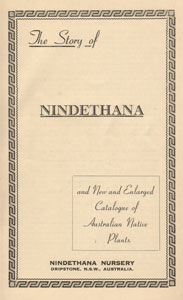 History of the horticulture of Australian native plants
History of the horticulture of Australian native plants
Reproduced from a 1956 booklet by G.W. Altofer, transfered to the web via optical character recognition (OCR). Nindethana Nursery was a significant step in the history of Australian native plants in Australia's horticultural industry. The Nindethana dream eventually became Burrendong Arboretum.
 The Story of Nindethana
The Story of Nindethana
BEGINNINGS.
In 1931 the whole countryside of the Central Western Slopes of N.S.W. was oozing with moisture from the abnormal rains. It seemed the ideal time to pick the site of our future home, for we fondly hoped that a place that was reasonably dry in 1931 would always remain so. Little did we dream that the freakish vagaries of the weather gods would bring the 65 inches of rain in 1950 and the 12 inches in seven days in February, 1955. During such prolonged downpours there are no dry spots. The solid clay underlying most of this country at such times turns to a slurry and will often bubble up through the tight crust of earth above it overnight. Even the bitumen roads do not escape and in many cases where the clay is deepest the pressure beneath makes the road bulge alarmingly. Then, as soon as the skin, so to speak, of the road is broken by traffic, whole patches of roadway collapse.
Our rainfall is 23 inches annually, spread fairly evenly over the twelve months with some heavy storms during the summer months and steady soaking winter rain in a normal year. We have, however, periodically, drought years when the rainfall drops to well below the 23-inch average. The driest year on record was 1944, with 9.65 inches of rain and the wettest (until 1950) was 34 inches in 1916. During the summer months the temperature frequently rises above 100 fahr. though seldom above 105 fahr. In 1939 we had one reading of 114 fahr. During, the winter there are frequent frosts when the temperature falls below 32 fahr. Most winters we have heavy frosts, but snow is rare. In 56 years we have had only three major falls, when the snow persisted in drifts and sheltered places for some days. Our coldest days in 1955 were in July, when ground readings of 19 and 20 degrees were registered. The lowest reading we Shave had at Nindethana was 18 degrees. You will note from the great variation in temperature that plants must be tough to survive. The bulk of Australian plants are just that. Some may be finicky as to soil requirements, but it is remarkable the number of species which will thrive in any one area, though they may originally have been native to such widely varying habitats as Kosciusko or North Queensland.
An amazing number of species from coastal areas and semi - tropical climates will grow and thrive in this climate provided we have the foresight in the first place to establish a wind-tight break of trees and tall shrubs foliaged to ground level. It is not so much the heavy frost that damages plants as the uninterrupted cold air flow. We have all remarked at various times on the cold bands of air that are met with in winter at various places in a short journey of, say, two miles. These are usually not wide and, side by side, are warmer air bands where the frostage will not be nearly so severe. Now if we plant a two or three row break of trees across the path of the air drift—and this usually is from south. south-west and west—we can make ALL the land in a garden as warm as the warmest part was before the break was planted. This is often quite 5 degrees warmer and means the difference between success and failure with certain border line plants. We have found that using this method it is quite possible to grow the W.A. flowering gum (Euc. ficifolia), Jacaranda, Macadamia and many other frost tender plants quite successfully, whereas before we had a decent wind break these species succumbed to frost damage year after year. Even when they over-wintered in a mild winter there would inevitably come that frost with the little extra “bite” which meant finish to many plants—even quite large flowering gums up to 4ft. tall.
Whilst on the subject of frost damage here is a little hint for those who have no breakwind (or for that matter where there is one but the frosts are particularly severe): Where a plant has a stem of from a foot or more high, take newspaper that has been dampened and wrap it tightly around the stem, tying firmly at the top and base. Spread the bottom portion out several inches from the base, placing earth on this so as to prevent cold air from percolating upwards. At least eight thicknesses of paper will be necessary. No cover will be needed on the top portion. If the sap stream can be kept warm the flow of sap will not be interrupted and damage to the top will be either obviated altogether or else be very slight. I have known gardeners who year after year go on trying to grow lovely trees such as our native Fire Wheel Tree (Stenocarpus sinuatus) and Jacaranda, only to have them reduced to a blackened stump from which the spring will bring with new hope fresh shoots, which will often make a growth of four or five feet during the summer, only to meet a like fate when winter comes. But we overstep the mark and the story of Nindethana only just beginning.
It is the year 1931 and, after much deliberation, we finally chose the site of our home on a gentle slope near the head of the valley of Burrill, looking north to where “out yonder n the distance the Blue Range curves and sweeps along the gleaming sykline to where the river sleeps”. There the massive ramparts of the Dickerton Range and Black Mountain rise up steeply from the usually placid Macquarie River—rise up a thousand feet from the river level into a series of tree-clad peaks, with here and there sheer cliff faces which are home and . haven for plants of many genera. Looking northward in winter from Nindethana over the intervenmq miles, quite often may be seen a sea of dazzling white No matter how often seen, it always has the effect of plucking at the heart shings Nindethana, set like a gem stone on a coronet above the white sea of the fog which blankets the lower levels and, in the far distance, the blue. tops of the cloud-islanded peaks beyond the river. To the east about a mile away rise the Sugar Loaf and the Gigmullarie Hills, heavily mineralised country where much gold has been won. To the West rise the rugged ardesite hills, chief of which are the Cobler covered top to bottom with White Pine (Callitris glauca) and the Lapstone.
When the sun is very low and the shadows of even de scending the hills to the East are laved with the last rays of sunlight, but it is always to “the deep ‘sea of the pine” that the roving gaze returns. For the pine hills speak of peace and beauty as no others can. They bring back memories of the long, long days of youth when we rode at racing pace along the narrow, winding paths on the steep, rockstrewn hillsides. Flashing kaleidoscopes of youth and the ways of youth, of its dreams and plans and, above all, the tangy scent of the pine wood. Or, after a sudden short, summer downpour, the sun striking through the pines caught and held the thousand jewels of the clinging raindrops. Each one in turn became a sapphire, a ruby or now flashing with opalescent hues until a sudden a wind gust tumbled the jewelled treasury to earth and oblivion.
Southward, a gently risina slope culminates in the mass of Bald Hill where the lava flow from Canobolas volcano stopped in the dawn years of our continent. This, then, was the site we picked, the house to be built on a narrow piece of deep 1igh soil with the typical yellowish gritty clay underlay. On the Eastern side conglomerate limestone cropped up and on the western side ironstone and slate. The whole 25 acres surrounding the homesite was bare and windswept and nomore than six trees of Euc. Albens (White Box) weré Standing on the area. Of these two had to come down to make way for the necessary buildings, but the remainder live on and have acquired hundreds of neighbours culled from the length and breadth of this fair land.
IN WHICH A NAME IS GIVEN AND AN IDEA IS BORN.
In a district renowned for its lovely liquid sounding native names it seemed natural for us to pick a native name. So Nindethana—meanina “ours”—was chosen to reign amonast such as Burrendong, Wuuluman and Morungulan. From 1932 some native plants, such as Hakea Laurina and Acacia podaliriaefoiia were planted. They throve exceedingly in the genialclimate and, as the years marched slowly by on silent feet, more and more native plants were given the right to air their graces. It was during these formative years that the idea slowly beqan to take shape in my mind of a great national garden to house all of our hardy native species, wherein would grow not just one or two of each species, but great clumps or aroves of 20 or 25 of each. America has its qigantic Arnold Arboretum, the home now of most of the hardy plants of the Northern Hemisphere, but none had attempted in Australia so far, on a national scale, the bringing together in one great garden all of our own hardy plants.
The Australian flora is unique and in the main it is very beautiful. As befits the world oldest land mass, we find here some plants which reach back to the beginnings of plant life. We have plants which have no living relatives in any other country of the world. There are many hundreds of species of. plants which are very near to extinction and some alas which have gone forever. In the future they will be known only from meagre dried specimens in the Herbaria of Australian Capital. Cities and overseas. What a sad reflection on our trusteeship of this great land. In the past it has been a case of apathy in governmental and semi-governmental places and also in 90 per cent. of cases of the general public. Something had to be done about this state of affairs and although at the beginning it was a one-man plan with but one shoulder to the wheel, as the years passed more and more helpers and workers have. been found.
Although it was not intendEd that Nindethana should become the site of the National Arboretum, it was intended,—and has become so in fact—it should be a proving ground or a pilot plantation for the larger project. The stocking of Nindethana Arboretum has meant many thousands of miles of. travel, a deal of correspondence and the gathering together in loose liaison of the grandest body of people in the world—. the native plant enthusiasts of Australia, N.Z., U.S.A., and elsewhere. It has not been a lonely searching and probing, but has been invariably enriched by the comradeship of my wife and my brother. To them no trail was too arduous, no day too long if the end held the promise of a new flower—and. frequently the long day’s end brought but the deadly tiredness. induced by miles of heatdom and th.e choking dust or, alternatively, the clinging mud of the inland trails.
If I might paraphrase something that Louis Bromfield once wiote in “Pleasant Valley” and apply it to Australia and Australians: “Those first pioneers and their descendents had passed over the surface of the land like a plague of locusts,. mining and destroying the land as they went.” That is not to say that all the actions of the pioneers were harmful. Much that these (in many cases) splendid people did was right and necessary. There was, however, uppermost in their minds the urge to clear the land, to destroy the accretion, the life bloodof a thousand thousand years of building. That has been ac complishe and, in some cases, is still under way with no thought of the future and of the “Sword of Damocles” that is poised ever, above their unhe.eding heads. The process of rapine and destruction has gone steadily on for a century and a ‘half, but it will not be so very long before Australia will find herself like U.S.A., with. no more broad acres to pilfer of the natural treasures; no more rivers to silt up; no more horizons to surmount Science has done much over the last decade to rectify some of the mistakes of the past, but even to-day, on the other hand, we find that science is aiding and abetting’ the work of destruction. By the simple process of adding this trace element or thgt to the virgin mallee or sand plain and waste lands, it has been found that valuable grazing land results. The point to be stressed is that vital ground cover s being destrored holus bolus with no thought to the treasures’ that have been built up within those plants from time immemorial. If only the ai.ithorities would learn from past mistakes and set aside strips of the mallee and sand plain wheró the shrub life could hold undisputed sway, we would have a reserve or nucleus of this unique flora which could be used for future expansion if necessary. The Soil Conservation Service is doing yeoman service on country already ravaged, but their be voice and the voices of we who understand to some slight extent the complexities of the situation are but tiny sounds in the wilderness.
TRIALS AND TRIBULATIONS.
When one has known the glory of our inland country ed and has seen and reverenced the scintillating beauty of the or’ flowers, the stateliness of the trees and the utilitarian value of plants without number, the desire to preserve some at least of of this heritage burns as a steady flame within. So many Ler ‘people think that Sydney is N.S.W. and the narrow fringe of well-watered coast is Australia. They are an integral part, but nd what a tiny part only time will show. To me it seems that any great National Garden must be situated on the Western side of the Dividing Range for no other part of Australia can grow so many genera of our plants and grow them so well. Whilst ‘Nindethana has some of the best attributes needed for a pilot plantation, it is not altogether ideal, lacking as it does an area of sand. However, beggars cannot he choosers and so, bit by bit, the Arboretum has been built up. This has been made possible by the great band of splendid helpers in all States, N.Z. and even in overseas countries. Verily this is a snowball that is ever growing. Often qreat things spring from tiny beginnings, and so it is with the finding and propaqating of many a rare and imperfectly known native plant. In many cases the chain of events begins like this: A more observant person in some isolated spot may see an unusual flower and ‘so one day there is a small package in the post addressed to Nindethana. Sometimes it is a plant rare in those parts’ but common in others. If that is so no harm is done and curiosity satisfied. On the other hand the specimen’may be something very rare indeed. Then identification is followed by a request is for seed, cuttings or plants. Then from being merely a thought-ful observer our friend becomes in some cases a very enthusiastic addict to the lore of the native plants. None of these people to my mind are ever thanked adequately, but we can only hope that the joy of seeing a rare plant going into many gardens and to sanctuaries may be a qreater reward than mere words. Do not run away with the idea that all help has been forthcoming from the country areas. There are the hundreds of plant lovers in the cities who have made available the floral treasures they have amassed during a lifetime of plant love. All of these and many another have contributed to the varied collection of plants in Nindethana Arboretum. In Darticular I want to pay tribute to my wife and my brother Peter. Without their zeal and help little could have been accomplished, and often, when on the verge of giving up, their steadfast help acted as a spur to fresh endeavour.
We have passed through many ordeals of drought, flood and fire and each has set us back a little, setbacks that acted as a whip urging all to greater effort. There have been many journeyings into the wastelands to North, South, East and West and when some gem has been snatched from the brink of oblivion, the glow of happiness is as a tonic and an urge to tired limbs and weary hearts. In 1944 with but 965 points. of rain in the twelve months, many plants in the infant arboretum were lost, as well as many in the nursery from the use. of mineral impregnated water, On 1st January, 1950, we had. a record hail storm which practically destroyed the nursery.. Heavy and continuous rain continued all that year so that at the end we had amassed 65- inches—nearly three times our annual average rain. The continuous rain defeated all efforts. to propagate plants successfully. For the next two years little was done to re-build the losses owing to my own illness. Down into the valley of the shadow and the slow emergence occupied a lot of valuable time. Hundreds of good friends have assisted in adding to the numbers of plants in the Arboretum, so that even with the floods of February-March, 1955,. and February-March, 1956, we have over 2,000 species in various stages of growth.
THE VISION SPLENDID.
This is a great land — a land of limitless possibilities of which we have merely scratched the surface. The future of Australia is linked with the development of the inland; and. when I say development, I mean the wise use of the land and all that grows thereon. Water is the key to the development. of this country, and none will deny that though the bulk of the inland in normal times is poorly watered, with the storage of even a portion of that liquid gold which yearly runs Lo waste we will have sufficient for most needs. Even were this. not so, with the great scientific advances of the past few years. what is to prevent us bringing sea water inland. The extraction of salt, chemicals and minerals and the use of the residue for irrigation would bring vast population and prosperity to the dry centre. A sane monetary system which will make that which is physically possible financially possible, coupled with the peaceful use of atomic energy, will make these dreams come true. Much of our dry country flora has. almost disappeared under the locust-like advance of civilisation. It is up to we of the present generation to see that ALL. of the living species of the inland plants are preserved for posterity. A modest beginning has been made at Nindethana, at the new National Arboretum at Dubbo, and on a more grandiose scale at Glen Morgan in Queensland. In the years to come we may well gaze over the wide expanse of these Arboreta and see much of our wonderful flora growing in happy unison. The glory of th.e Western Australian sand plain flora and that of her meagre upland country was not made to vanish under the wrecking hand of what we are pieased to term progress.
It is not only the W.A. wild flower areas which are clothed in floral beauty. South Australia, the dry Centralian uplands, the old inland sea fringe of Queensland, New South Wales and Victoria, the Victorian Grampians, the high alpine areas, rthe coastal sandstone as well as the tropical northland each add their quota of grace, quaintness and scintillating loveliness. Whilst ever flowers are grown we shall each sing the praises of same floral gem, but to me one picture is stamped indelibly on the mind. It is that of the Erernophila species of Western Queensland. These flowers of the inland are seen there in all their bewildering variety. Seven or eight species grow to perfection in the 100 miles between Cunnamulla and Thargomindah. Firstly there are miles of E. maculata and E. glabra and wherever this combination occurred, fantastic hybrids were the rule. The influence of E. glabra had the effect in this area of breaking up the usual crimson flowers of E. Maculata into a myriad colours. There were clear yellows progressing to deep orange and onward through a bewilderinq array of colours, from pale pink to the deepest of reds. These are plants mainly of the sometimes flooded hollows between the ridges. On the hard ridges great drifts of E. latrobei, with fits dazzling scarlet or cerise pendant flowers, made splashes of glorious colour. On the sand hills, gravel ridges arid deep sandy loam three species were associated.
F. Bowmani, often tall with powder white, densely hirsute leave and stems and large bells from palest blue to deepest purple; E. gilesi and E. goodwini, lower growing but massed with blue flowers, often covered the ground for miles. Near here also we saw large areas of E. duttoni with sine large orange scarlet fiowes and with floral bract flared out like dancers’ skirts. To bring these and a thousand others together in loose liaiso is a vision to grip and hold the imagination. In all the to-morrows in Nindethana, in Glen Morgan and the Dubbo National Arboretum those who come after us will go to study or just to feast on the peerless beauty and the everlasting variety of our flora. We may confidently hope that. many thousands of species will grow in these Arboreta in happy unison in great groves and clumps. From all the far-flung lands of the earth, students will come to study our plants, just as they do .those of the old world in the Arnold Arboretum in U.S.A. What Nindethana began it may well be that Dubbo and perhaps Glen Morgan will bring to triumphant conclusion.
June 14, 1956. G.W.Althofer
![An Australian Government Initiative [logo]](/images/austgovt_brown_90px.gif)







